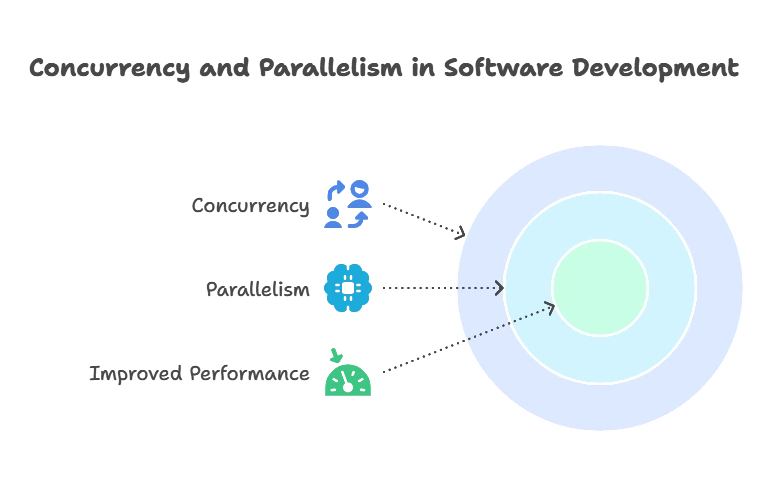Concurrency and Parallelism in Python
In this topic, we'll explore the concepts of concurrency and parallelism in Python, covering everything from the basics to advanced techniques. We'll discuss how to write concurrent and parallel programs to improve performance and efficiency, using various Python libraries and tools. Let's dive into the details!
Introduction to Concurrency and Parallelism
In this section, we’ll provide an overview of concurrency and parallelism, explaining their differences and similarities, and why they are important in modern software development.
Understanding Concurrency
Concurrency refers to the ability of a system to handle multiple tasks simultaneously, making progress on each task in overlapping time periods. In Python, concurrency can be achieved using threads, coroutines, or asynchronous programming.
Understanding Parallelism
Parallelism, on the other hand, involves the simultaneous execution of multiple tasks, typically on multiple CPU cores or processors. Parallelism aims to maximize resource utilization and improve performance by dividing tasks into smaller units that can be executed concurrently.

Concurrency in Python
In this section, we’ll focus on concurrency techniques in Python, including threading, multiprocessing, and asynchronous programming.
Threading
Threading in Python allows multiple threads of execution to run concurrently within a single process. Threads share the same memory space but can execute different tasks independently.
Example:
import threading
import time
def print_numbers():
for i in range(5):
print(i)
time.sleep(1)
thread = threading.Thread(target=print_numbers)
thread.start()
thread.join()
Explanation:
- In this example, we create a new thread
threadthat executes theprint_numbersfunction. - The
print_numbersfunction prints numbers from 0 to 4 with a delay of 1 second between each print statement. - We start the thread using the
start()method and wait for it to complete using thejoin()method.
Multiprocessing
Multiprocessing in Python allows multiple processes to run concurrently, taking advantage of multiple CPU cores or processors. Each process has its own memory space and runs independently of other processes.
Example:
from multiprocessing import Process
import time
def print_numbers():
for i in range(5):
print(i)
time.sleep(1)
process = Process(target=print_numbers)
process.start()
process.join()
Explanation:
- In this example, we create a new process
processthat executes theprint_numbersfunction. - The
print_numbersfunction behaves the same as in the threading example. - We start the process using the
start()method and wait for it to complete using thejoin()method.
Parallelism in Python
In this section, we’ll explore parallelism techniques in Python, including parallel processing using libraries like multiprocessing and concurrent.futures, as well as GPU acceleration using libraries like Numba and CuPy.
Parallel Processing with concurrent.futures
The concurrent.futures module provides a high-level interface for asynchronously executing callables, allowing for easy parallelism in Python.
Example:
from concurrent.futures import ThreadPoolExecutor
import time
def print_numbers():
for i in range(5):
print(i)
time.sleep(1)
with ThreadPoolExecutor() as executor:
future = executor.submit(print_numbers)
future.result()
Explanation:
- In this example, we use a
ThreadPoolExecutorto asynchronously execute theprint_numbersfunction in a separate thread. - We submit the function to the executor using the
submit()method, which returns aFutureobject representing the result of the function call. - We wait for the function to complete using the
result()method of theFutureobject.
GPU Acceleration with Numba and CuPy
Numba is a just-in-time compiler for Python that translates Python functions to optimized machine code, allowing for high-performance computing on the CPU and GPU. CuPy is a NumPy-compatible library for GPU acceleration.
Example:
import numpy as np
import cupy as cp
@cp.jit
def square(x):
return x ** 2
x_cpu = np.arange(10)
x_gpu = cp.arange(10)
print(square(x_cpu)) # Output: [ 0 1 4 9 16 25 36 49 64 81]
print(square(x_gpu)) # Output: [ 0 1 4 9 16 25 36 49 64 81]
Explanation:
- In this example, we define a
squarefunction using Numba’s@jitdecorator, which optimizes the function for execution on the CPU and GPU. - We create NumPy arrays
x_cpuandx_gpuand apply thesquarefunction to both arrays. - The function executes efficiently on both the CPU and GPU, thanks to Numba’s optimization and CuPy’s GPU acceleration.
In the above topic, we've explored the concepts of concurrency and parallelism in Python, covering techniques for concurrent and parallel programming using threads, processes, asynchronous programming, and GPU acceleration. By understanding and applying these techniques, you'll be able to write more efficient and scalable Python code, making the most of modern hardware architectures and improving the performance of your applications. Happy coding! ❤️
